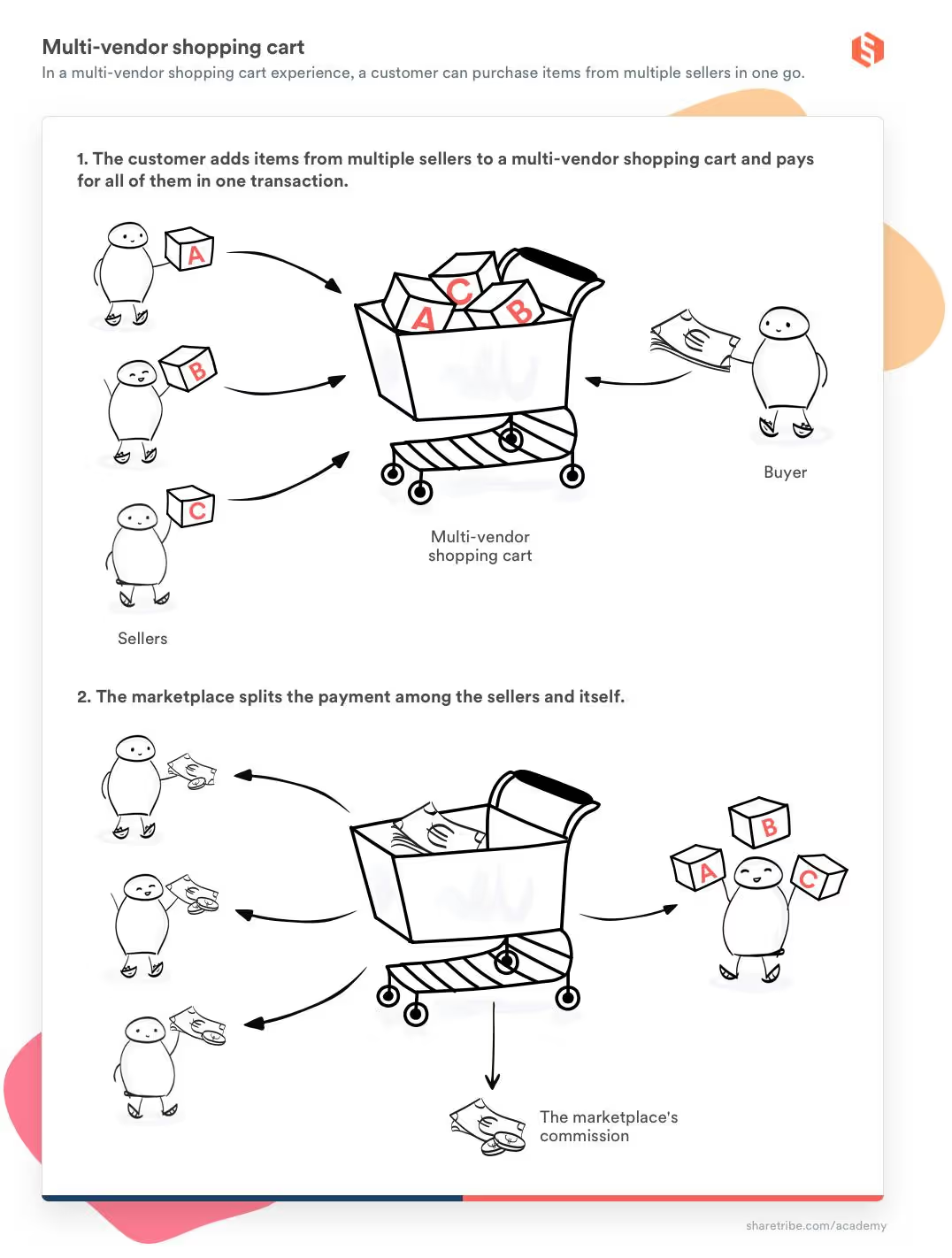Sharetribe shopping cart plugin: Boost Marketplace Conversion

Don’t ruin your customer experience on Sharetribe just because you skipped the most critical feature—an intelligent marketplace shopping cart.
If your cart doesn’t support grouped checkout or distinguish between sellers, the result is frustration—for users and your brand. Whether you're building a niche platform or scaling a multi-vendor marketplace, your cart can either drive conversions—or drive people away.
Let’s explore how the Sharetribe shopping cart plugin can improve buyer journeys and why it should be your first major upgrade.
Sharetribe Shopping Cart: Everything You Need to Know
Before jumping in, it’s important to understand: Sharetribe is powerful—but doesn’t come with a native, full-featured shopping cart.
As Juho Makkonen, CEO of Sharetribe, explains in his official article, Sharetribe offers maximum flexibility but leaves out a built-in shopping cart intentionally—because different marketplace business models require fundamentally different cart behaviors. This means it's up to you to choose (and build) the right cart logic for your specific use case.
There are two main types you should consider:
Single-vendor Shopping Cart: Simple and Streamlined
A single-vendor cart means a buyer can only purchase from one seller per transaction. Once that checkout is complete, they can start a new transaction with another seller.
Common use cases include booking marketplaces, service-based platforms, or high-ticket product platforms.
Key advantages:
- Technically easier to implement
- Fewer edge cases
- Clean user flow, ideal for services or appointment-based marketplaces
Limitations:
- Not suitable for traditional product marketplaces
- Limits upselling and cart size
This model works best for platforms that offer experiences like home rentals, appointment bookings, or freelance services. Buyers expect to transact with one provider at a time, and the simplicity of this model supports that expectation.
Multi-vendor Shopping Cart: The Amazon-Style Experience
A multi-vendor cart allows users to add products from multiple sellers into the same cart and checkout in one go. The system then splits the order, sends relevant parts to each vendor, and tracks them individually.
Ideal for physical product marketplaces with varied vendors—think fashion, home goods, or specialty items.
Key advantages:
- Seamless user experience
- Increased average order value (AOV)
- Essential for most eCommerce-style marketplaces
Limitations:
- Technically complex to implement
- Requires order splitting, custom notifications, and commission logic
- Demands strong Sharetribe development expertise
Multi-vendor carts unlock convenience and flexibility, but only if they’re implemented with precision. Done wrong, they can introduce friction that hurts your brand.
When Do You Need a Single Sharetribe Shopping Cart?

From a business perspective:
This model works best when your platform is designed around delivering unique, high-value services—often involving human coordination, approval steps, or time-bound bookings.
For example, marketplaces that connect clients with consultants, therapists, or accommodation providers typically rely on one-to-one interactions where the buyer expects to deal with a single provider at a time. This approach allows vendors to maintain clearer service standards, cancellation policies, and pricing models.
From a technical perspective:
Single-vendor carts are significantly easier to implement and maintain. There's no need to split orders or handle multi-vendor commissions, which reduces backend complexity and minimizes friction during checkout. It also means fewer integration points with scheduling tools, notifications, and payment systems—making this setup ideal for MVPs or lean, service-focused platforms.
In short, if your business is more about matching people than products, and operational simplicity is key, the single-vendor cart is your go-to solution.
Marketplaces for tutors, rental hosts, therapists, or consultants typically benefit from this model. It provides a clean, one-to-one user experience that aligns with customer expectations.
When Do You Need a Multi-Vendor Sharetribe Shopping Cart?

From a business perspective:
This setup is crucial for scaling product-based marketplaces. It empowers buyers to shop freely across vendors, increasing cart value and improving conversion rates. This model also supports promotions, product discovery, and upselling strategies—factors essential to competing with modern eCommerce platforms. It’s the go-to solution for marketplaces that operate like curated department stores or online bazaars.
From a technical perspective:
Multi-vendor carts introduce complexity but open up vast potential. The system must intelligently split orders by vendor, trigger individual notifications, and handle separate commission structures. You’ll also need to manage shipping logic, stock synchronization, and possibly tax rules per seller. These challenges are real—but with the right architecture and development team, they’re completely solvable.
In practical terms, here’s when you should strongly consider building a multi-vendor shopping cart into your Sharetribe marketplace:
- Sells physical goods from various vendors
- Encourages browsing, bulk buying, and bundled offers
- Aims to increase average cart value and customer retention
Your buyers don’t want to jump through hoops just to complete a simple purchase. If someone is shopping for a candle from one vendor and a throw blanket from another, they expect one cart and one seamless checkout.
That’s what users demand in 2025—and that’s what you need to deliver.
But here’s the catch: building a reliable, conversion-optimized multi-vendor cart on Sharetribe isn’t easy. It requires careful orchestration of product logic, checkout rules, and backend processes.
This is where expert help makes all the difference.
Journeyhorizon – Your Premium Marketplace Expert
We’re not just Sharetribe developers—we’re marketplace architects with strategic insight and executional excellence.
At Journeyhorizon, we build high-performance Marketplace Shopping Cart solutions that are not only technically sound, but purpose-built to match your marketplace vision and growth plan. Whether you're launching your MVP or scaling into new markets, our solutions are tailored to your stage and ambitions.
As a trusted Sharetribe Partner—and one of the few with real-world experience across both product and growth—we’ve delivered results for marketplaces across industries, including:
- End-to-end multi-vendor cart systems, supporting split payments, dynamic availability, and order routing
- Optimized user experiences, increasing conversions and reducing cart abandonment rates through UX testing and analytics
- Custom integration layers, handling tax automation, vendor-level commission structures, third-party logistics, and notification workflows
What sets Journeyhorizon apart is our ability to blend marketplace business strategy, product thinking, and engineering—all while staying aligned with Sharetribe’s evolving capabilities and best practices.
From vision to deployment, we bring structure, clarity, and momentum to your marketplace build.
Looking for a Sharetribe Partner who understands both tech and traction? Let Journeyhorizon guide your next step—book a free consultation today.
Conclusion
A well-designed Sharetribe shopping cart isn’t just another feature. It’s a strategic foundation for growth.
Whether you're starting with a single-vendor flow or preparing for a complex multi-vendor experience, your Sharetribe shopping cart directly impacts your user satisfaction, retention, and revenue.
Don’t lose sales due to clunky checkout. Don’t confuse customers with inconsistent cart logic. Don’t wait until launch day to realize your Sharetribe shopping cart setup is holding you back.
Frequently Asked Questions (FAQ)
What is a Sharetribe shopping cart?
A Sharetribe shopping cart allows buyers to add one or more listings to a cart before checking out. Depending on the configuration, it can support purchases from a single vendor or multiple vendors simultaneously.
What’s the difference between single-vendor and multi-vendor carts in Sharetribe?
A single-vendor cart limits checkout to one seller per transaction, while a multi-vendor cart enables buyers to purchase from multiple vendors at once—splitting orders, handling commissions, and simplifying user experience.
Can I add a multi-vendor shopping cart to my Sharetribe marketplace?
Yes, but it requires custom development. Sharetribe doesn’t include a native cart, so implementing a multi-vendor system involves building out order logic, vendor workflows, and integrations. Journeyhorizon can help with that.
Do I need a shopping cart for a service-based marketplace?
If your marketplace involves bookings, appointments, or services, a single-vendor cart—or no cart at all—may be more appropriate. It depends on your platform’s business model.
Why should I work with a Sharetribe Partner like Journeyhorizon?
Journeyhorizon combines deep Sharetribe expertise with strategic marketplace insight. We don’t just build carts—we help you design the right experience to increase conversions, streamline operations, and grow confidently.



